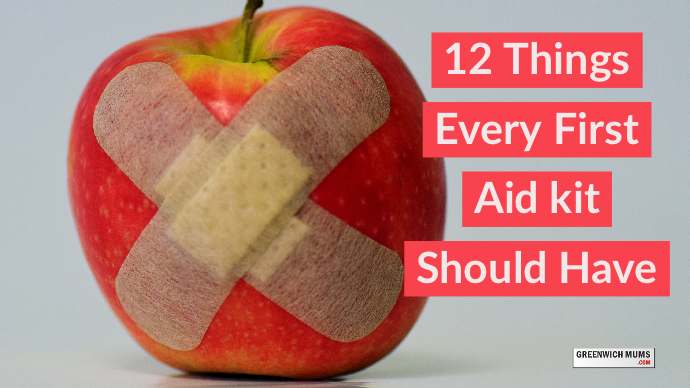First Aid Kit? Everyone (parent or not) should have a home first aid kit ready to go should an emergency arise. If you have small kids, being prepared with up-to-date equipment becomes even more critical. It also gives you a sense of more control and much peace of mind. Or at least it does for me, Just knowing that with my kit, always well stocked and within easy reach, I should be able to cope with the majority of disasters and injuries.

Here is a handy checklist of items your first aid kit should, at a minimum, contain:
1. Antiseptic: My American friends swear by Bactine. Although Boots Antiseptic wound wash works just as well. Cleaning scrapes and grazes is essential for preventing infection. If soap and water aren’t available, using antiseptic will flush out debris and provide mild pain relief. Antiseptics come in cream, spray or liquid form. (like TCP) Many, will also provide pain relief too. first aid kit
2. Adhesive Tape: Used to secure any bandages, help form splints and tap gauze into place. At a push also act as an emergency plaster! first aid kit
3. Analgesic pain relief: Two small bottles of child-friendly liquid paracetamol and ibuprofen. Treats headaches or pain due to injury. first aid kit
4. Antihistamine: In the case, someone may suffer from severe allergies. Some sort of antihistamine is a good idea. first aid kit
5. Bandages: Especially Tubular Support and slings. Both come in handy for a variety of situations. (sprains and possible breaks)
6. Bandaids and gauze pads: Bandaids treat injuries of all sizes. Buy a large pack that comes in a variety of sizes. Patterns and colour will help distract smaller the people! Gauze pads, buying bigger sizes work best because you can always cut them down to the size you need. Gauze pads work well for more severe injuries too.
7. Cold and Hot Pack: These one-time use only packs are an excellent addition to your kit. They can be applied to sprains, bruises, and bumps to reduce swelling.
8. Latex Gloves: A helpful addition to any first aid kit, providing a sanitary way to protect against blood, bacteria bodily fluids, and other contaminants that you may encounter in an emergency situation.
9. Rubbing alcohol and disinfectant: Perfect for cleaning insect stings bites or wounds. Alcohol wipes are particularly convenient to have in your kit because they donít take up much space.
10. Scissors: Scissors are often overlooked in many kits and come in handy not just for cutting bandages and plasters, but for cutting clothing, tape, and anything other materials or obstructions.
11. Tweezers: Like scissors above, tweezers are often overlooked too and come in handy to remove stingers, ingrown hairs, splinters, and hangnails.
12. Finally a list of emergency phone numbers: Keep an index card with the telephone numbers of your doctor, dentist, national poison centre, (DAIL 111) and all other emergency contacts. Also, it’s a good idea to write down the name of any family members who have allergies, and medications they take on a regular basis.